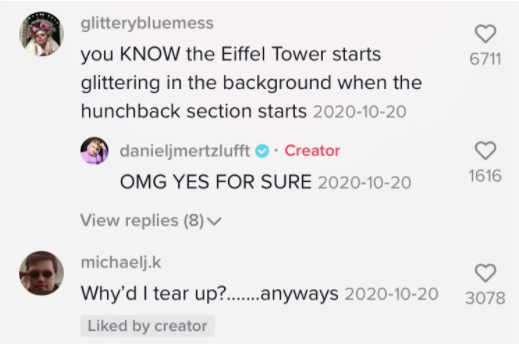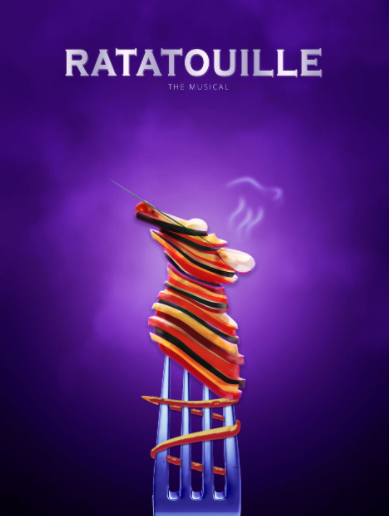
Ratatousical: what the TikTok musical says about society
The Ratatousical is a musical created on TikTok that adapts the Disney film Ratatouille. What does this musical reveal about society in the time of a pandemic?
In early 2020, the pandemic hit and millions were suddenly stuck at home. This resulted in a lot of boredom, and people needed to find projects to keep busy. The social media platform TikTok had a huge surge in popularity, and people used the platform to share their creative ideas and inspiration for new projects. On August 11, 2020, Emily Jacobsen (known as @e_jaccs on TikTok) shared a "love ballad” to Remy the rat from Disney’s Ratatouille that she had written in her free time. The song took off and other users quickly started adding their own songs and dances. This was the start of Ratatouille the musical, or the Ratatousical.
Remy the rat
The song consists of a single, high-pitched voice singing: “Remy the Ratatouille, the rat of all my dreams. I praise you my Ratatouille." It is directed towards Remy, one of the main characters in Ratatouille. Remy is a rat (not a ratatouille, which is a dish, contrary to what the ballad suggests) with great taste and ambitions of becoming a chef. In the film, Remy sees Alfredo Linguini, a human, ruining a soup in the kitchen of the restaurant he works at and goes to save the soup. The soup turns out to be delicious, and from then on Remy sits in Alfredo’s hat, tugging his hair to guide his cooking.
"...Lots of glitter, Remy center stage listening to his adoring fans praise him..."
Jacobsen’s ballad got a lot of attention and has been used in 18.5 thousand TikToks. On October 20, 2020, Daniel Mertzlufft posted a TikTok wherein he added vocals and instruments to Jacobsen’s song, making it a musical finale number. The TikTok had the following caption:
“REMY: The Musical Act II Finale OG Song By @e_jaccs. You need to imagine a FULL ensemble belting this out. Like 40 people. Big Act II finale. Lots of glitter, Remy center stage listening to his adoring fans praise him. Here comes the big ending… CONFETTI EVERYWHERE! LIGHTS GOING CRAZY! REMY ON A LIFT FLYING OVER THE AUDIENCE!!! BLACKOUT. END OF SHOW. COMING TO BROADWAY 2021!”
The comments were positive, and people started to further discuss what the scene would look like. In Figure 1, one user imagines the Eiffel Tower glittering in the background (the movie takes place in Paris), while another expresses their emotional response to the song.

Figure 1: Comments under Daniel Mertzlufft’s Ratatouille TikTok.
As the nascent musical gained more attention, many users started to imagine scenes, songs for other characters, stage designs, choreography, costumes, make-up looks, and even a poster design (Figure 2).

Figure 2: Ratatousical’s poster
As the vision for the musical grew, people started to post “auditions” using the music and choreography of others. Even celebrities like Kevin Chamberlin, known as the butler in the Disney show Jessie, started to join in by posting a TikTok contributing to the musical.
Playbill comes to play
Playbill is a magazine about theatre and Broadway. On November 21, 2020, the official Playbill TikTok account posted about the “should be real musical.” Although it was simply a nice gesture, it was seen as a win that Playbill even mentioned the project, and it stirred up even more interest in the imagined musical. However, after seeing the enthusiasm, Playbill announced on December 9 2020 on TikTok that the musical was “getting a concert presentation.”
On January 1st, the musical premiered, with professional actors, a live recorded soundtrack from the Broadway Sinfonietta orchestra, ensemble, dancers, and a choir. The end product was created by a group of TikTokers in collaboration with Broadway professionals. It consisted of videos each actor had recorded at home due to COVID restrictions. Remy the Rat's story was told with clever editing, portraying the characters as together in one room, even though they were spread all over the world. Tickets ranged from $5 to $100, with viewers deciding for themselves how much they wanted to spend. Later on, an encore performance was shown on TikTok, which was free to watch but donations were encouraged. As of now, Ratatousical has collected $2 million dollars, which will be donated to The Actors Fund, which helps actors in the pandemic.
Quarantine culture
Ratatousical was not the first or last musical produced on TikTok, but rather part of a culture of similar TikTok musicals that circulated during the pandemic. On September 23, 2020, the aforementioned Daniel Mertzlufft posted a similar musical scene about a couple fighting in a grocery store. People added to the TikTok and by October the song included many characters, including a dad, mom, child, employer, can of soup, squeaky shopping cart wheel, automatic door with a too-loud bell, and a random voice over the grocery store speaker. Mertzlufft was invited to the Late Late Show with James Cordon, who created a similar musical about Thanksgiving.
Then on January 10, 2021, Abigail Balow (@abigailbarlowww) posted a TikTok saying: “Ok, but what if Bridgerton was a musical?” Bridgerton is a Netflix series that premiered at the very end of 2020, and Barlow created a song about the main characters. It immediately had the same effect as the Ratatouille musical: people started to imagine scenes, gave ideas for lyrics, and danced and sung to the songs. Barlow started working with Emily Bear and they are currently working together to make a full concept album. They livestream their writing sessions and viewers give suggestions in the comments. Bridgerton the musical has also gotten a lot of media attention, including Playbill.
"It shows that there is a large part of society that is not comfortable with producing nothing for a long time."
This TikTok musical culture tells a lot about the current state of society. Firstly, it shows that many people are bored. With lockdowns, quarantines, and just general social distancing, people have had a lot more time. To fill this new free time, many activities have become widespread, such as bread baking, embroidery, and creating music. It shows that people need something to do. Although there are many people that can just watch Netflix for hours, these activities show that there is a large part of society that is uncomfortable with long periods of unproductivity. They need a tangible activity to do, like writing or making music.
It also shows that there may be a lot of repressed creativity due to the business of ordinary life. Especially for generation Z, nothing has ever completely paused everyday life like the pandemic has. Seeing this sudden outburst of creativity makes one wonder about how much normal daily life is obstructing people from doing what they want. Before COVID-19, one would get up, commute to work or school, come home, cook and eat, do chores, and go to bed. Perhaps on the weekends a free activity could be done, but these were often also occupied by chores and social engagements. However, now that many people have much more time, they have embraced hobbies that normally would not be a priority. As Netflix became too boring, people have sought other forms of entertainment, which mostly seem to involve creativity.
Political unrest and rats
Furthermore the Ratatousical reveals society's need for distraction and social cohesion. Apart from the obvious decrease in social contact due to COVID-19 and social distancing, 2020 has also been filled with a more implicit forms of division. The past year has seen many political disruptions, such as the U.S. elections and mass protests. The world looks like a scary place. By using TikTok, people can focus on something else and be distracted from the state the world is in. The Ratatousical offered a creative outlet and distraction but also represents an online space where people can work together on a non-political project. It created a sense of unity to have a project that everyone can be proud of. As seen in Figure 3, one user comments “i’m so excited for when gen z is in charge of everything.” It made people proud to be part of a generation and excited for the future.

Figure 3: A comment about the future.
At the beginning of the musical screening, Emily Jacobsen gave a small introductory talk about the production of the musical and their vision:
“Together we imagine a broadway that celebrates the artistic brilliance and historic work of everyone in our community, especially theater workers who are black, indigenous and people of color. A broadway that uplifts the voices of women and queer artists.”
Her emphasis on diversity, which can also be seen in the cast, reflects a year in which racism and diversity were important topics, for example regarding the Black Lives Matter protests and discrimination against the LGBTQ community. The fact that she announced her commitment to diversity so explicitly demonstrates that she knows how important it is and that the casting was done thoughtfully. There has been much discussion of diversity problems on Broadway, for example criticism that is it too white. Her speech makes clear that diversity is not yet normalized, but rather is an ongoing movement that needs attention and intentional statements.
Longing for theatre
Although for some people their need for creativity may have been a new discovery, theatre fans have always been aware of it. As COVID-19 hit, live musicals and plays had to be canceled. The fact that fans filled this gap themselves through their own online musical shows the importance of theatre. As soon as that sector was no longer able to work, it was “replaced” by a modified fan version. It is a sign of resilience that the theatre community did not throw in the towel but rather solved the problem for themselves.
Further the fact that the musical collected $2 million dollars for actors in need shows both the size and support of theatre community as well as interest and compassion from those outside the community. It shows that even though people may be struggling, they are open to supporting others and finding solace in a divided world.
The Ratatousical shows that online platforms like TikTok have a significant impact on culture, both online and offline
Furthermore, the collaboration between TikTokers and Broadway professionals tells us something about the influence of online culture in the online-offline nexus. Broadway shows mostly take place in the offline world, with many celebrities and talented performers. It is a prestigious phenomenon that may seem distant to ordinary people. However the Ratatousical grew to the point that they no longer could ignore it. Although some people may argue that TikTok is simple entertainment and is culturally insignificant, the Ratatousical shows that online platforms have a significant impact on culture, both online and offline.
Ratatousical reflections
In short, the Ratatousical reflects our current society in many ways. The community-built musical, emblematic of TikTok quarantine musical culture, shows that people are bored and need something to fill up their time. But it also reveals that a lot of creativity has been suppressed by daily life. Furthermore, it seems that there is a need for distraction from the tumultuous and divided world we live in, and a need for social cohesion in the form of a group project. Jacobsen’s opening speech is further emblematic of the ongoing journey to normalize diversity, both in Broadway and in society as a whole.
The musical was a sign of resilience, as theatre lovers took care of their hunger for theatre themselves while also funding actors in need. Lastly, the musical demonstrates the influence of online platforms on both online and offline culture. All in all, the production of the Ratatousical seems like time well-spent, as it gave people a hobby, friends, and something to be proud of.